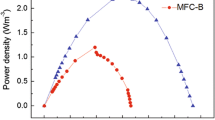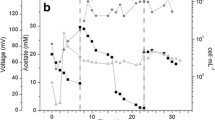Abstract
Four microbial fuel cells (MFCs) inoculated with different bacterial species were constructed. The species were Pseudomonas putida, Comamonas testosteroni, Corynebacterium gultamicum, and Arthrobacter polychromogenes. The MFCs were operated under identical continuous flow conditions. The factors affecting the capabilities of the MFCs for treating organic matter and generating power were evaluated and compared. The factors include microbial species type, organic loading, and substrate degradation rate. For all four MFCs, power output increased with the organic loading rate. Power density also increased with the substrate degradation rate. These findings implied that more organic matter was utilized for power generation at higher organic loading and substrate degradation rates. However, coulombic efficiency increased with decreased organic loading and substrate degradation rates. Apparently, all four MFCs had low efficiencies in generating power from organic matter. These low efficiencies are attributed to the long distance between the anode and the cathode, as well as to the small ratio of the proton exchange membrane surface area to the anode chamber surface area. These features may have caused most of the protons produced in the anode chamber to leave the chamber with the effluent, which led to the low power generation performance of the MFCs.









Similar content being viewed by others
References
Behera M, Ghangrekar MM (2009) Performance of microbial fuel cell in response to change in sludge loading rate at different anodic feed pH. Bioresour Technol 100:5114–5121
Biffinger JC, Byrd JN, Dudley BL, Ringeisen BR (2008) Oxygen exposure promotes fuel diversity for Shewanella oneidensis microbial fuel cells. Biosens Bioelectron 23:820–826
Bond DR, Lovley DR (2003) Electricity production by Geobacter sulfurreducens attached to electrodes. Appl Environ Microbiol 69:1548–1555
Chaudhuri SK, Lovley DR (2003) Electricity generation by direct oxidation of glucose in mediatorless microbial fuel cells. Nat Biotechnol 21:1229–1232
Clesceri LS, Greenberg AE, Eaton AD (2001) Standard methods for the examination of water and wastewater. American Public Health Association (APHA), American Water Works Association (AWWA), and Water Environment Federation (WEF), Washington, DC
Du Z, Li H, Gu T (2007) A state of the art review on microbial fuel cells: a promising technology for wastewater treatment and bioenergy. Biotechnol Adv 25:464–482
Finch AS, Mackie TD, Sund CJ, Sumner JJ (2011) Metabolite analysis of Clostridium acetobutylicum: fermentation in a microbial fuel cell. Bioresour Technol 102:312–315
Ghangrekar MM, Shinde VB (2007) Performance of membrane-less microbial fuel cell treating wastewater and effect of electrode distance and area on electricity production. Bioresour Technol 98:2879–2885
Gil GC, Chang LS, Kim BH, Kim M, Jang JK, Park HS, Kim HJ (2003) Operational parameters affecting the performance of a mediator-less microbial fuel cell. Biosens Bioelectron 18:327–334
Hubenova Y, Mitov M (2009) Potential application of Candida melibiosica in biofuel cells. Bioelectrochemistry 78:57–61
Ieropoulos I, Winfield J, Greenman J (2010) Effects of flow-rate, inoculum and time on the internal resistance of microbial fuel cells. Bioresour Technol 101:3520–3525
Jiang J, Zhao Q, Zhang J, Zhang G, Lee D (2009) Electricity generation from bio-treatment of sewage sludge with microbial fuel cell. Bioresour Technol 100:5808–5812
Juang DF (2001) Effects of mono- and di-valent cations on the zeta potential and settling velocity of activated sludge. J Chin Inst Environ Eng 11:11–20
Juang DF, Chiou LJ (2007) Microbial population structures in activated sludge before and after the application of synthetic polymer. Int J Environ Sci Technol 4:119–125
Kim BH, Kim HJ, Hyun MS, Park DH (1999) Direct electrode reaction of Fe(III) reducing bacterium, Shewanella putrefaciens. J Microbiol Biotechnol 9:127–131
Kim HJ, Park HS, Hyun MS, Chang IS, Kim M, Kim BH (2002) A mediator-less microbial fuel cell using a metal reducing bacterium, Shewanella putrefaciens. Enzyme Microb Technol 30:145–152
Logan BE, Regan JM (2006) Electricity-producing bacterial communities in microbial fuel cells. Trends Microbiol 14:512–518
Mathuriya AS, Sharma VN (2009) Bioelectricity production from paper industry waste using a microbial fuel cell by Clostridium species. J Biochem Technol 1:49–52
Min B, Logan BE (2004) Continuous electricity generation from domestic wastewater and organic substrates in a flat plate microbial fuel cell. Environ Sci Technol 38:5809–5814
Min B, Cheng S, Logan BE (2005) Electricity generation using membrane and salt bridge microbial fuel cells. Water Res 39:675–1686
Mohan SV, Mohanakrishna G, Sarma PN (2010) Composite vegetable waste as renewable resource for bioelectricity generation through non-catalyzed open-air cathode microbial fuel cell. Bioresour Technol 101:970–976
Oh S, Logan BE (2006) Proton exchange membrane and electrode surface areas as factors that affect power generation in microbial fuel cells. Appl Microbiol Biotechnol 70:162–169
Park HS, Kim BH, Kim HS, Kim HJ, Kim GT, Kim M, Chang IS, Park YK, Chang HI (2001) A novel electrochemically active and Fe(III)-reducing bacterium phylogenetically related to Clostridium butyricum isolated from a microbial fuel cell. Anaerobe 7:297–306
Pham CA, Jung SJ, Phung NT, Lee J, Chang IS, Kim BH, Yi H, Chun J (2003) A novel electrochemically active and Fe(III)-reducing bacterium phylogenetically related to Aeromonas hydrophila, isolated from a microbial fuel cell. FEMS Microbiol Lett 223:129–134
Rabaey K, Verstraete W (2005) Microbial fuel cells: novel biotechnology for energy generation. Trends Biotechnol 23:291–298
Rabaey K, Boon N, Siciliano SD, Verhaege M, Verstraete W (2004) Biofuel cells select for microbial consortia that self-mediate electron transfer. Appl Environ Microbiol 70:5373–5382
Ren Z, Ward TE, Regan JM (2007) Electricity production from cellulose in a microbial fuel cell using a defined binary culture. Environ Sci Technol 41:4781–4786
Rodrigo MA, Cañizares P, Lobato R, Paz R, Sáez C, Linares JJ (2007) Production of electricity from the treatment of urban waste water using a microbial fuel cell. J Power Sources 169:198–204
Rodrigo MA, Cañizares P, García H, Linares JJ, Lobato J (2009) Study of the acclimation stage and of the effect of the biodegradability on the performance of a microbial fuel cell. Bioresour Technol 100:4704–4710
Schroder U, Nieben J, Scholz F (2003) A generation of microbial fuel cells with current outputs boosted by more than one order of magnitude. Angew Chem Int Ed Engl 42:2880–2883
Sun J, Hu Y, Bi Z, Cao Y (2009) Improved performance of air-cathode single-chamber microbial fuel cell for wastewater treatment using microfiltration membranes and multiple sludge inoculation. J Power Sources 187:471–479
Wang X, Feng Y, Lee JH (2008) Electricity production from beer brewery wastewater using single chamber microbial fuel cell. Water Sci Technol 57:1117–1121
Watson VJ, Logan BE (2010) Power production in MFCs inoculated with Shewanella oneidensis MR-1 or mixed cultures. Biotechnol Bioeng 105:489–498
Zhang T, Cui C, Chen S, Yang H, Shen P (2008) The direct electrocatalysis of Escherichia coli through electroactivated excretion in microbial fuel cell. Electrochem Commun 10:293–297
Acknowledgment
The authors would like to express their gratitude and appreciation to the National Science Council (NSC) of Taiwan for the financial support of this research under Contract No. 99-2221-E-276-004.
Author information
Authors and Affiliations
Corresponding author
Rights and permissions
About this article
Cite this article
Juang, DF., Yang, PC., Chou, HY. et al. Effects of microbial species, organic loading and substrate degradation rate on the power generation capability of microbial fuel cells. Biotechnol Lett 33, 2147–2160 (2011). https://doi.org/10.1007/s10529-011-0690-9
Received:
Accepted:
Published:
Issue Date:
DOI: https://doi.org/10.1007/s10529-011-0690-9




